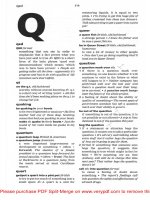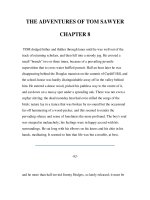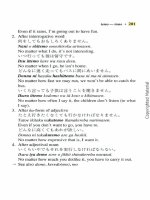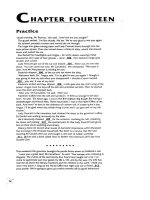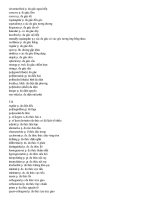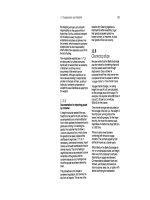Sound Patterns of Spoken English phần 8 pdf
Bạn đang xem bản rút gọn của tài liệu. Xem và tải ngay bản đầy đủ của tài liệu tại đây (123.05 KB, 15 trang )
108 Experimental Studies in Casual Speech
representation (features, phonemes, words) and programmed to
interact with other levels. These researchers claim that the resulting
complex system (TRACE) shares features with human speech per-
ception in being able to map acoustic input into words and in the
kinds of mistakes which it makes.
Gaskell, Hare, and Marslen-Wilson trained a PDP to match a
citation form on one hand with place-assimilated forms on the
other (so, for example, ‘screen’ will be the output associated with
‘screem’, ‘screeng’ or ‘screen’). ‘Feature bundles’ were used instead
of phonetic symbols in order to reduce the arbitrariness of the
mapping (so that, e.g. [m] and [n] were identical save one feature)
and to look at the question of underspecification (which will not be
pursued here). Results indicated that the PDP could learn that the
response ‘screen’ could come from the mentioned set of similar-
but-not-identical stimuli.
In a second experiment, phonological variants were input along
with the environments which condition them, so the training data
included material like ‘screen play’, ‘screen test’, ‘screem play’,
‘screeng colour’. Again, the citation forms were given as the cor-
rect output. The PDP showed signs of learning that non-coronal
segments could be mapped into coronal representations, but also
made mistakes, as do humans. While one is ill-advised to accept
that humans and PDPs work along the same lines, we can tentatively
conclude that if PDPs can make generalizations of this sort, it is
very likely that humans can, too.
Gaskell and Marslen-Wilson advocate an algorithmic approach
which works on underlying phonological principles, but these
experiments suggest only that many-to-one mappings are possible.
If a lexical item is represented in the mind by a variety of traces
with different pronunciations one of them being the citation form,
the same end is achieved as when active phonological processes are
in operation, but perception of a reduced form is passive rather
than algorithmic: if a trace is sufficiently stimulated, a percept will
occur. They admit (p. 435) that the connectionist (PDP) approach
uses a single mapping process so that algorithmic activities are only
indirectly represented.
A possible difficulty with this approach is that words are often
phonetically vestigial in casual speech to the extent that they cannot
Experimental Studies in Casual Speech 109
contribute much to a lexical entry. The ‘and’ described in experiment
3 is realized only as a nasal consonant, and part of the information
in this consonant is about place of articulation of the first sound in
the following word. It may be that some sequences of words will
be represented in their entirety in the trace lexicon, so that ‘and
they’ can be a single entry.
4.3 Summary
Before the middle of the twentieth century, most work on English
pronunciation was aimed at specifying the correct way to articulate
standard citation forms. Exceptions to this were found in sociolin-
guistics, but comments about casual forms were buried in treatises
in which the focus was on other matters. By the end of the century,
interest had grown considerably, largely under pressure of increased
efforts towards recognition of speech by computer (see chapter 5).
It is still fair to say, however, that the study of casual speech pro-
nunciation is underrepresented in the literature. Wells’ Accents
of English (1982) contains much useful information, but is not
primarily aimed at the description of casual speech. In-depth impres-
sionistic studies of several standard varieties (SSB., Am., Australian)
have been made, but accurate, up-to-date descriptions of non-
standard varieties are extremely rare. The increased use of labelled
databases will almost certainly make studies which profile the
various realizations of citation forms in casual speech easier to do
and therefore more frequent.
Embarking on an experimental study of casual speech produc-
tion is intimidating because variables are normally not controllable
and one can never predict the number of tokens of a particular pro-
cess one is going to elicit, which in turn makes the application of
statistical measures difficult or impossible. Both production and per-
ception studies of tapping, t/d deletion, glottalling, l-vocalization,
and many other casual speech features have, however, been done,
and a patchy picture is beginning to build up about how these
function in some accents of English.
Experimental studies of perception of casual speech are on the
increase, though most work done by psycholinguists to date has
110 Experimental Studies in Casual Speech
dealt only with a few minor processes such as consonant assimila-
tion. Preliminary results strongly suggest that phonology actively
mediates between phonetic input and lexical entries in English.
Phonology is not the only answer, however: holistic perception
involving other information seems to be in operation in perceiving
highly reduced speech.
Skoyles (2001) makes the amusing observation that speech per-
ception theories fall into two categories: Reading and Soup. The
Reading paradigm assumes that speech is processed linearly, an
item (whatever these may be) at a time until a percept is achieved.
Chapter 4 examines a theory of this sort and concludes that it has
difficulty in accounting for the perception of casual speech sentences
containing familiar reductions. The Soup paradigm assumes that
information from a variety of sources is combined, not necessarily
in linear or chronological order, to produce an eventual percept.
This chapter suggests that the second paradigm must be taken
seriously, though there is no reason to believe that it cannot function
in conjunction with Reading.
Applications 111
5
Applications
As suggested in earlier chapters, the fact that conversational speech
processes are regular and predictable means that they can be con-
sidered part of phonology.
5.1 Phonology
5.1.1 Writ small in English, writ large in other languages
It was argued in chapter 1 that the transition between phonetics
and phonology is indeterminate, like the boundary between boiling
water and the steam above it. Molecules are exchanged in both
directions, and it is difficult to say whether a particular molecule
at a given instant belongs to liquid or gas. The processes discussed
in chapter 2 are relatively superficial, and some would say they are
phonetic rather than phonological. Yet it is very noticeable that
many of these processes, while relatively minor in English, form
quite major parts of the phonology of other languages and language
history, reflecting their status as natural processes.
Final consonant devoicing, for example, occurs in the Slavic lan-
guages, German, Dutch, Turkish, Canadian French (Archambault
and Maneva, 1996) and a large number of other languages as a
regular and unexceptional process. It is also found in child lan-
guage, another clue to its natural status. Final devoicing can even
112 Applications
extend to vowels in certain cases and is a regular feature of Brazilian
Portuguese.
Vowel devoicing of high vowels between voiceless obstruents is
a well-known feature of Japanese but also occurs in Korean (Jun
and Beckman, 1994), Turkish (Jannedy, 1994) and Shanghai Chin-
ese (Zee, 1990). It has already been mentioned in chapter 2 that
vowel nasalization and nasal dropping gure prominently in the
history of French and Portuguese.
L-vocalization before consonants has played a part in the history of
the Romance languages e.g. Latin > Vulgar Latin alter, French autre,
Spanish otro, Portuguese outro. Modern Portuguese also shows nal
l vocalization as a living process: Spanish mal, Portuguese mau.
Even when not represented in the spelling, the pronunciation of nal
l in Portuguese is vocalic: hotel [octyọ]. In Polish, the sound which
is spelled ặ was once a dark (velarized) [l], but in modern Polish, it
is pronounced the same as [w]. While this is not exactly vocalization
(given that [w] is not a vowel), it shows the same process of loss of
tongue-tip contact. There are vocalic consequences: sequences spelled
ặu/ặú or uặ/úặ are all pronounced [u:]. Since long vowels do not play
a role in Polish, [u:] is interpreted as /wu/ or /uw/. Loss of tongue
contact for ặ has thus brought about a reorganization of the Polish
consonant system: whereas once there was a three-way contrast
among ặ, l, and w, there is now a two-way contrast between l and w
(i.e. ặ and w have coalesced) (Jassem, 2001, personal communication).
Palatalization is attributed to many languages, but it is not easy
to nd a language other than English in which palatalization ap-
plies only with following palatal approximants. Southern Brazilian
Portuguese shows regular palatalization of /t/ and /d/ before high
vowels, as in quente [ck*(n) i] and grande [ỡĩ.(n)ui]. Many
other languages show a sequence k t , ỗ or before non-low
vowels, Swedish (Kerstin [cỗyậtữn] and Italian cento [c ynto]
being obvious cases.
Lenition (weakening) is a term which crops up frequently in
language descriptions. Notionally, it refers to a diminution of the
energy used to pronounce an underlying phonological unit within
a word in a particular linguistic environment. Lenition can have a
grammatical function: in Welsh (where a typical lenition is voiceless
stop voiced stop fricative), it gives information about word
Applications 113
class of the word in which it applies, that of a neighbouring word
or both. For example, a feminine singular noun will show lenition
after the definite article: cadair ‘chair’; y gadair ‘the chair’. The
feminine singular noun will, in turn, cause lenition in a following
adjective: merch ‘girl’, pert ‘pretty’, y ferch bert ‘the pretty girl’.
(The m → f change, while part of lenition, is not so obviously
related to our casual speech phenomena.)
Finno-Ugric languages show lenition (called ‘gradation’ in this
case) in related forms of words. Estonian has three degrees of con-
sonant quantity and in this case lenition tends to reduce a con-
sonant by one degree: rääkida (to speak) ma räägin (I speak). (These
consonants are both phonologically voiceless; the second is short.)
In other languages, lenition is simply a marker of phonological
position (allophony): in Spanish and Breton (Dressler, 1975: 24),
voiced intervocalic stops are realized as voiced fricatives or some-
times approximants. The second category is where English must be
classified: lenition in casually spoken English is represented largely
by decreased closure in obstruents, though tapping and its attend-
ant intervocalic voicing could be thought of as weakening as well.
The reduction in length of consonant clusters could be considered
a type of quantity lenition such as found in Estonian, though it
generally serves no grammatical function.
The examples above demonstrate cases where a phonological
process is minor in English but major in another language. Dressler
(1975: 228) points out that even within a given language the same
processes often operate in ‘allegro’ (casual speech) as major rules and
in lento (formal/citation form speech) as minor rules. This could be
said to be true of some processes found in English, such as [st] sim-
plification: the failure to pronounce spelled ‘t’ in ‘hasten’, ‘fasten’ and
‘Christmas’ represents a minor exception, while its non-appearance
in sequences such as ‘last minute’ and ‘first place’ is ubiquitous.
5.1.2 Historical phonology
It has often been observed that much historical linguistics has to be
based on written language: there are no speakers of, say, Gothic
upon whom to try one’s reconstructions. Since written texts have a
strong tendency to be conservative both in terms of preserving
114 Applications
outdated pronunciations and in terms of being elevated in style,
they normally are more representative of citation form than of
unselfconscious casual speech.
Dressler (1975: 227) is one of the few to comment on the import-
ance of casual speech to historical phonology:
One of the greatest problems of historical phonology seems to me to
be that practically nothing but lento forms are handed down . . . We
therefore can see only the tip of the iceberg, so to speak, with
respect to the then-available forms of the various styles of speech.
Forms from less careful styles . . . are handed down only irregularly.
Therefore, when one speaks of ‘irregular’ sound changes, it is only
justified from the standpoint of lento phonology, which up to now
has been practically the only topic in the history of language.
He gives the example (p. 229) of Latin viginti ‘twenty’ instead of
the expected vicinti: a case, he believes of a single casual form
penetrating into the standard language. ‘The natural weakening
process which is called lenition already existed in the Latin allegro
style: only in the early Romance period did it come in as a lento
sound change. However, the allegro process penetrated into single
forms like viginti even in lento style and is therefore handed down
as an irregular sound change in that word.’
Dressler advocates using not citation form and not the most
reduced casual style as the basis for historical linguistics, but some-
thing in between.
Variation: the crucible of change
Any natural language shows variation in pronunciation of both
consonants and vowels at any time you choose. This variation is
partly conditioned by environment and partly unconditioned in the
sense that we have a good notion of where a variant will occur,
but we cannot guarantee it. This is presumably an aspect of what
Weinreich, Labov and Herzog (1968) call ‘orderly heterogeneity’.
Further, one variant (in a particular environment) is regarded as
more standard than the others and today’s standard may not be the
standard of tomorrow. E.g. pronunciation of intervocalic ‘d’ as [d]
Applications 115
is standard in English and other pronunciations are regarded as
nonstandard. On the other hand, what is spelled ‘d’ and was once
presumably pronounced as [d] is now [Î] intervocalically in stand-
ard Danish. The fact that a continuant pronunciation of /d/ now
exists intervocalically in casual English and that intervocalic lenition
is a natural process suggests that one possible path for the standard
English /d/ of tomorrow is in the direction of Danish (though the
result would probably be alveolar instead of dental). But it is equally
true that this path may not be taken: today’s standard may be main-
tained, or another variant may become conventional. Tomorrow’s
standard will, however, predictably come from the set of today’s
pronunciations: for a completely novel variant to suddenly predomin-
ate would be very odd indeed.
Predictions about the sorts of variation one might expect in a
particular system are possible: it is a recurrent theme in phonology
that changes move in the direction of simplicity, naturalness, or
unmarkedness. Bailey (1972: 36) says, ‘the patterns of a language
are the cumulative results of natural, unidirectional changes’ and
(p. 37) ‘the directionality of natural change is from what is more
marked to what is less marked.’
Stampe (1979) argues convincingly that marking conventions
(i.e. calling a form ‘marked’ or ‘unmarked’) are superficial and
unrevealing and that ‘implicational laws, to the extent that they
hold, are nothing more than empirical generalizations regarding
the effects of natural processes’ (p. 50). These processes, in his
view, can thus be seen as opening avenues for sound change (see
chapter 3), but, again, not deterministically.
Predictions about which variations will lead to change remain,
at best, risky. Labov has contended that sound change in progress
can be observed by studying language in its social context (Fasold,
1990: 227). He readily admits, however, that all change involves
variability, but not all instances of variability involve change
(Weinreich et al., 1968: 188).
It should not be forgotten that not all sound changes can be
considered movements towards a more natural situation. Bailey
(1973a: 131) points out that borrowing and ‘typological adjustment’
(Vennemann, 1972: 240) can be the basis of changes ‘towards the
marked case’. He cites the example of Hawaiian: when /k/ became
116 Applications
a glottal stop in this language, /t/ changed to /k/ (arguably) to
become maximally different from /p/, the only remaining stop. Since
a system without /t/ is more marked than a system without /k/,
this is change, in his terms, towards increased markedness. Bailey
(p. 37) also discusses the apparent anomaly that whereas intervocalic
lenition of stops is certainly common and is normally considered
to be natural, it leads to the inclusion in the phonetic/allophonic
inventory of unusual (marked) segments such as [±] and [x].
Vaissière (1998: 70) wittily observes that sound changes cannot
be predicted, but they can almost always be given a number of
more or less plausible explanations after they have been attested.
She adds that not all phonological changes are related in an obvious
way to observed continuous speech phenomena, citing raising of
tense vowels, lowering of lax vowels, and fronting of back vowels
as being among those historical processes not often observed as
casual speech processes. Donegan (1993: 12) argues (independ-
ently of the casual speech process) that processes of this type are,
however, natural, phonetically motivated, and, in a sense, predict-
able: ‘Tensing increases color [palatality or labiality] and decreases
sonority and Laxing increases sonority and decreases color. Tense-
ness thus makes vowels more susceptible to raising, and laxing
makes vowels more susceptible to lowering . . .’
The pronunciation of casual speech thus cannot explain every-
thing about historical phonological change. It can usefully be re-
lated to not only processes found in other languages but also to
possible future standard pronunciations of one’s own language. A
hypothesis which deserves more attention is that that if a variation
is found only in casual speech in one language, it will inevitably be
found in other languages as part of the standard phonology. This
is congruent with Bailey’s contention (based on Decamp, 1971 and
Elliot, Legum and Thompson, 1969) that linguistic variation pat-
terns in an implicational manner (1972: 28) (though he did not
mean interlinguistically).
Collective unconscious?
Historical linguists have observed that the same change can occur
(apparently independently) in several sibling languages after they
Applications 117
have broken away from the parent. Latin aurum, for example,
yielded Spanish, Italian oro, and French or. Based on this, some
linguists have suggested that members of language families have
internal tendencies towards particular changes which can be trig-
gered by some unknown catalyst (Sapir’s ‘drift’, Schultze’s ‘speech
predisposition’, cited in Dressler, 1975: 230). A much more likely
explanation is that a pronunciation (here the one with [o]) was
part of the vernacular system at the time these languages split off
from the parent. The change then ‘percolated up’ from below to
surface as a standard form in each of the sister languages.
We know, in fact, that [o] or [Ñ] for /au/ was variably present in
vulgar Latin (Hall, 1968: 91; Smith, 1983: 903). While this might
be seen as natural and for this reason alone within the scope of
change for each of the sister languages, it is more than coincidence
that it found its way into the standard system of each of them. As
Dressler (p. 230) puts it, ‘The appearance of independence is induced
by the one-sided consideration of only lento phonology [in the
parent language], since the sound change at issue can have been in
existence as an allegro rule long before the separation. The problem
of the causality of simultaneously-occurring changes is restricted
thereby to the question of why a “cognate” allegro rule in separate
languages will work its way more or less simultaneously into the
lento systems.’
One can see the same slow emergence of vernacular forms
with respect to loan phonology. ‘If one accepts that the substratum
languages influence the superstratum languages first at the popular
level, therefore most in allegro styles, one can explain the para-
doxical observation that substratum phenomena seem to show up
for the first time very late in our documents, long after the extinction
of the substratum in question’ (Dressler, 1972: 229).
5.2 First and Second Language Acquisition
5.2.1 First language acquisition
It is often claimed that the speech used by caretakers to infants is
especially clear and may be subconsciously designed to improve
118 Applications
communication and possibly even promote language learning by
providing a simple model. There is considerable evidence that (in
some but not all cultures) child-directed speech differs from adult-
directed speech in intonation, syntax, vocabulary, speed, and rate
of repetition, but little work has been done on phonological input
to young children.
Shockey and Bond (1980) recorded eight British mothers speaking
to their two-to-four-year-old children and to adults in a relaxed
home environment. They looked at phonological reductions such
as final t-glottalling, Î-assimilation, and one type of cluster simpli-
fication (final -ts → s) and found that mothers used significantly
more reduced forms to their children than they did to adults.
We have argued in chapter 2 that phonological reduction is, on
the whole, not done consciously, so that being able to purposely
vary the degree of reduction in different situations is unlikely. Yet
phonological reduction appears to be part of the complex be-
haviour associated with talking to infants, at least in Anglo culture.
Of course, the ‘Idn’t oo a pitty wittle beebee’ stereotype of infant-
directed speech is a gross exaggeration of what is found, but it
captures the fact that reduced speech is informal and intimate. We
hypothesized that mothers used it as a way of expressing solidarity
and affection towards their young children.
We then asked how children acquire correct lexical representa-
tions if (as is often believed), the primary caretaker is the major
language model. We concluded that the answer lies in the varia-
bility in the speech used by and to the caretaker. In the first place,
speech directed by them to children is not uniform: our results
showed that input from the caretaker does contain examples of
unreduced forms. Secondly, simply because child-directed speech
rarely contains citation forms does not ensure that the child is
deprived of the opportunity to hear formal variants, both those
used by the caretaker to other adults and those directed at the
caretaker in the child’s presence.
It thus seems likely that hearing a range of inputs allows children
as well as adults to create a model of permissible variation in pro-
nunciation and that casual forms are easily interpreted by children
as affectively positive.
Applications 119
5.2.2 Second language acquisition
For a 19-year-old Dutch undergraduate who, after 6 years of Eng-
lish at a grammar school and after a whole year of studying English
at a Dutch university, goes to England for the first time in his
life . . . steps off the train, goes up to a porter and asks the way to
Victoria bus station, it is a traumatic experience to find out that he
does not understand a single word the porter says to him. (Koster,
1987: 1)
Most people who have lived in a foreign country empathize deeply
with Koster’s dismay: it was only after two years in Brazil that
I could understand the speech of strangers in a bus queue, and even
then I made mistakes.
Needless to say, there are many factors which contribute to
understanding a foreign language. One obvious factor which does
not seem to have received much attention in the literature is the
connected speech processes outlined in chapter 2: especially if
taught by non-native speakers of English, students are unlikely to
have had significant contact with naturally reduced speech.
Brown (1977, 1996) uses this premise as a platform for her book
Listening to Spoken English. Few attempts are made, she observes
on her first page (1972), to teach English as spoken by native
English speakers. Though many foreign visitors speak English
reasonably comprehensibly, they cannot understand it. She cites an
article in a 1971 English newspaper reporting that ‘many overseas
students are unable to understand English as spoken by university
and college lecturers’, sometimes to such an extent that they give up
their course of studies. If this is to be remedied,
The foreign student, then, is going to have to learn to abstract the
message from a fairly reduced acoustic signal. He will not hear a
string of explicitly articulated sounds which he can build into words
and then sentences. He will hear an overall sound envelope with
moments of greater and lesser prominence and will have to learn to
make intelligent guesses, from all the clues available to him, about
what the probable content of the message was and to revise this
interpretation if necessary as one sentence follows another – in short,
he has to learn to listen like a native speaker (p. 4).
120 Applications
Dressler (1975: 219) comments, ‘Fast speech rules . . . are one of
the most important parts of phonology in its application to the
teaching of foreign languages, where fast speech phonology has
previously been neglected. This is because the allegro forms of the
foreign language are not properly learned or taught or because the
speaker erroneously applies allegro rules of the native language to
foreign languages.’ (Also see Dressler, 1971.)
Both Koster and I ask how native speakers and non-natives dif-
fer in their perception of connected speech. I have done a few pilot
studies based on this question.
Experiment 1
The first experimental sentence mentioned in chapter 4, ‘The screen
play didn’t resemble the book at all’, gated in stages of approxi-
mately 50 msec. (a total of 33 stimuli), was presented to 16 non-
native speakers of English. A reminder of the phonetic transcription
follows:
[ÎvcskflHmply}d}
d
Úfl}z*mb<ÎvcbäkvtcÑÕ]
All subjects had studied at The University of Reading for at least one
year, were surrounded (during the day, at least) with an English-
speaking environment, and had had all of their lectures in English.
Otherwise, there was little uniformity in this group of listeners: they
came from different countries and had been in England for varying
lengths of time.
The most obvious result was that only four of the sixteen listeners
understood the sentence entirely correctly.
Working our way through the time course of the sentence, ten
listeners first heard ‘scream’ but changed it to ‘screen’. This change
was much more spread out in time than in the case of the native
speakers: five of the ten non-natives made the change as soon as
the conditioning factor ([p]) appeared, the others during ‘resemble’
or ‘all’.
Only four arrived at a correct interpretation of ‘didn’t’, two of
these during the phrase ‘at all’.
Applications 121
Experiment 2
The same gated sentence was presented to 16 native speakers of
Hong Kong Cantonese, all young women studying to be teachers
of English who had achieved a high score on an English proficiency
test. They had more contact with each other than with native speakers
of English, though their course was delivered in English.
The most striking feature of the results is that no one understood
the entire sentence though some were able to capture its phonetic
profile. Below is a subset of the answers. Interestingly, some of the
Hong Kong teachers made the switch from ‘scream’ to ‘screen’ but
were not able to use the derived information productively.
The screen played is at the bottom book of tall.
The screen played example of book at all.
The screen play thin reasonable book at top.
The screem played n ressembled of book at all.
The screen played isn’t resemble the book at all.
The scrim plated resemble the booked at all.
The scream pladenn resemble the book at all.
The scream play dern resemble the book at all.
The screem played in resimple the book at all.
The last few subjects seem to have all the phonetic information
they need to interpret the sentence correctly. We assume that a lack
of familiarity with casual speech is a major factor in their lack of
comprehension (though it has been pointed out that ‘screenplay’ is
a rather unusual vocabulary item and this may well contribute
significantly to its lack of recognition).
Experiment 3
The second sentence used in my experiments in chapter 4, which is
composed entirely of familiar vocabulary
[s
w
}
w
v
w
sckwa}ˆ_ ä!f.næ Ääw}∞n<vcwyd÷º:âÍ]
So it was quite good fun, actually, on the wedding, though.
122 Applications
was presented in gated form to nine native speakers of Greek.
Several of these had lived in England for over ten years, and two
were married to native English speakers.
None of the listeners got the whole sentence correct. Only one
(who attributed her perceptual expertise to long evenings of field
work in the pub) recognized the first word, ‘so’.
Of the eight who heard the stressed word ‘quite’, three were early
perceivers, one recognized it at the end of ‘fun’ and one recognized
it at the beginning of ‘wedding’.
The two subjects with English spouses heard ‘good fun’ as it was
being said. Two other subjects recognized ‘fun’ at its completion
and one during the word ‘on’. Four Greeks recognized ‘wedding’
(though two reported ‘Reading’, the town in which they live).
It will be remembered that this sentence was difficult for the
native speakers, calling for considerable context before it could be
interpreted. Not surprisingly, the Greek speakers, despite their long
and frequent exposure to English, found it very difficult indeed.
Discussion
In general, non-native speakers take longer than natives to interpret
relaxed conversational input. They depend heavily on syntactico-
semantic information to arrive at an understanding rather than
using phonological context to disambiguate reductions. It appears
that by and large they are not processing the language as it comes
in, but rather taking in a relatively large amount of spoken lan-
guage to process and thereby introducing a processing lag, much
as predicted by Brown (1977) in the quotation above. Results by
Truin (quoted in Koster, 1987: 33) bear this out: non-natives need
more acoustic-phonetic information than natives for the recognition
of isolated words. Koster’s own results (p. 136) show that non-
natives make more errors in identification of speech sounds and
that they take longer to identify those that they get right.
Of course, gated speech cannot be regarded as equivalent to
speech which is produced naturally as a communicative act in an
appropriate situation, and one could argue that non-natives would
have done better in a real-life situation (though Koster (p. 27)
argues to the contrary, since gating allows subjects much more
